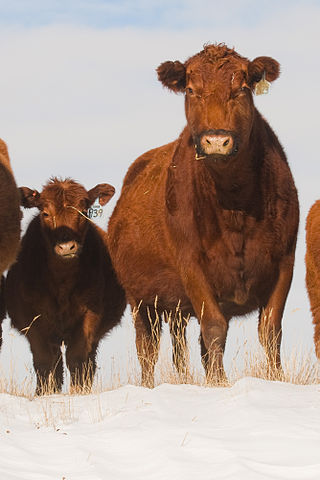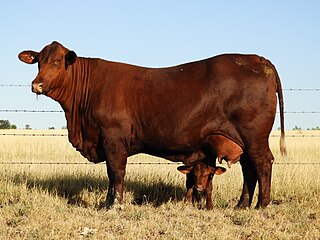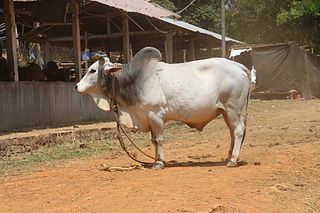
The Texas Longhorn is an American breed of beef cattle, characterized by its long horns, which can span more than 8 ft (2.4 m) from tip to tip. It derives from cattle brought from the Iberian Peninsula to the Americas by Spanish conquistadors from the time of the Second Voyage of Christopher Columbus until about 1512. For hundreds of years the cattle lived a semi-feral existence on the rangelands; they have a higher tolerance of heat and drought than most European breeds. It can be of any color or mix of colors.

The Hereford is a British breed of beef cattle originally from Herefordshire in the West Midlands of England. It was the result of selective breeding from the mid-eighteenth century by a few families in Herefordshire, beginning some decades before the noted work of Robert Bakewell.

The Charolais or Charolaise is a French breed of taurine beef cattle. It originates in, and is named for, the Charolais area surrounding Charolles, in the Saône-et-Loire department, in the Bourgogne-Franche-Comté region of eastern France.

The Brahman is an American breed of zebuine-taurine hybrid beef cattle. It was bred in the United States from 1885 using cattle originating in India, imported at various times from the United Kingdom, India, and Brazil. These were mainly Gir, Guzerá and Nelore stock, with some Indu-Brasil, Krishna Valley and Ongole. The Brahman has a high tolerance of heat, sunlight and humidity, and good resistance to parasites. It has been exported to many countries, particularly in the tropics; in Australia it is the most numerous breed of cattle. It has been used in the creation of numerous taurine-indicine hybrids, some of which – such as the Brangus and Brahmousin – are established as separate breeds.

The Simmental or Swiss Fleckvieh is a Swiss breed of dual-purpose cattle. It is named after the Simmental – the valley of the Simme river – in the Bernese Oberland, in the canton of Bern in Switzerland. The breed is typically reddish in colour with white markings, and is raised for both milk and meat.

The Red Angus is an international breed of beef cattle characterised by a reddish-brown coat colour. It derives from the Scottish Aberdeen Angus population and is identical to it in all but coat colour. Red Angus are registered separately from black Angus cattle in Australia, Canada, and the United States.

The Santa Gertrudis is an American breed of beef cattle. It is a taurine-indicine hybrid breed, descended from both zebu and European cattle. It was bred in the early twentieth century in Texas, and received official recognition in 1940. It has been exported to many countries including Australia, Brazil and South Africa, and has contributed to the development of a number of modern breeds, among them the Barzona and the Droughtmaster.
The Kostroma is a Russian cattle breed developed in the first half of the 20th century in the Kostroma Oblast of Russia's Upper Volga region, based mostly on crossbreeding local improved cattle with Brown Swiss, Allgau cattle and Ayrshire bulls. They are similar in appearance to Brown Swiss, but longer in head and body with a narrower forehead.

The Karabair is a long-established horse breed from Central Asia, and particularly from Uzbekistan and northern Tajikistan. It results from the cross-breeding of desert horses of Arabian or Turkmene type from the south with steppe horses from the north. It is a small, agile and versatile horse that can be used for riding or driving. It is well suited to local horse sports, and especially to the Uzbek national game, kokpar. It is also used for meat and milk production; the milk may be made into kumis.

The Sussex is a British breed of red beef cattle from the Weald of Sussex, Surrey and Kent, in south-eastern England. Its traditional use as a draught ox on the Weald continued into the twentieth century. From the late nineteenth century it began to be selectively bred for beef production. It has been exported to many countries of the world; the largest population is in South Africa, where there may be half a million head.
The Georgian Mountain is a local cattle breed from The Republic of Georgia.They can be black, black and white or red and white in colour. It is a very small breed, adapted to the harsh mountain conditions of the Caucasus; average height at the withers is 100 cm for cows and 112 cm for bulls. The live weight of mature cows is 220–280 kg and that of bulls is 270–370 kg.

Kalmyk cattle is a breed of beef cattle of the former Soviet Union, now found in the Russian Federation, in Kazakhstan and in Tajikistan. It is believed to have originated in Dzungaria, and to have been brought into south-eastern Russia by migrating Kalmyks in the seventeenth century.
The Semirechensk is a Kazakh breed of domestic pig. It was purpose-bred in the twentieth century in the Kazakh Soviet Socialist Republic of the Soviet Union. The breeding stock was principally Large White, with some admixture of Siberian Kemerovo and a small proportion of wild boar.

The Droughtmaster is an Australian breed of beef cattle. It was developed from about 1915 in North Queensland by crossing zebuine cattle with cattle of British origin, principally the Beef Shorthorn. It was the first Australian taurindicine hybrid breed; it is approximately 50% Bos indicus and 50% Bos taurus.

The Malvi or Malavi, also known as Manthani or Mahadeopuri, is breed of zebu cattle from the Malwa plateau in western Madhya Pradesh, in central India. It is a good draught breed; the milk yield of the cows is low.
The American Breed is an American bovid hybrid of cattle with a small percentage of American Bison blood. It was developed in the 1950s by a New Mexico rancher looking for beef cattle which could survive on poor fodder in the arid Southwest.

The Hereford Hog or Hereford is an American breed of domestic pig. It is named for its color and pattern, which is similar to that of the Hereford breed of cattle: red with a white face.
Turano-Mongolian cattle are a group of taurine cattle that are found in Northern and Eastern Asia. They are morphologically and genetically distinct from the Near-Eastern group of taurine cattle, from which European cattle are descended; they may have been domesticated independently.

The Rathi (Hindi:राठी) is an Indian breed of dairy cattle. It originates in the state of Rajasthan, and is found principally in the Thar Desert, in the Bikaner, Ganganagar and Jaisalmer districts of the state. It is particularly numerous in the tehsil of Lunkaransar, in Bikaner District. In 2022 the total number of the cattle was estimated at 878852–1169828 head.
Edilbay sheep, also known as Edilbaev(skaya) sheep, are a breed of domesticated sheep which originated in northern Kazakhstan. This breed belongs to the coarse-wooled fat-tailed type of sheep and the Kazakh group. It originated in the 19th century as a cross between Kazakh fat-tailed sheep and Kalmyk/Astrakhan coarse-wooled sheep. Today, it is found in Kazakhstan and Russia.














